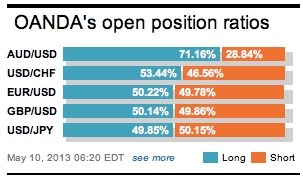In a bearish frenzy, the 17-member single currency remains somewhat under pressure this morning, slicing through a different handle, while contemplating testing longer-term support levels well below the sub-1.30 level. The question remains, will this broader bid for the “mighty” dollar, fueled by the Abenomic Yen’s move outright above 100 and now 101, last? Breaching ¥100 has garnered a lot of attention and will surely keep the pressure on the Japanese government to back up the Bank of Japans actions with perhaps an aggressive economic reform program. With a Fed policy that is loose, and US data reducing the prospect of further action from the Fed while other central banks remain more active in easing, has helped renew demand for the dollar in general. But, is there more?

Historically, ‘big dollar’ gains in the US often take on the feel of a patriotic bid and are rarely maintained. In this case, the dollar bid could shift, rather naturally, into a more risk-on feel that is concentrated in JPY or CHF funding – an environment that suits the ‘carry trade.’ Logically, there should be better value than being long USD/JPY – perhaps this market should expect investors to gravitate toward GBP and EUR/JPY. The current neutral US yield levels (10’s trade near its two-month mid-point) reflects the “underlying mood of a gradual US recovery with continued Fed pumping.” Now that other central banks are adding greater stimulus, the allure of higher yield and risk play should intensify, supported by further JPY and CHF losses.
This current dollar rally has been fuelled from various sources, starting with yesterdays better than expected weekly jobless data. Pushing the ‘mighty buck’ along was Fed Plosser’s forecast that US unemployment would print +6.5% by the end of 2014 – he also indicated that he would welcome the Fed slowing down QE or its current bond-buying program. Even chatter that the Chinese wanted more dollars within striking distance of this market’s psychological ¥100-benchmark has only “snowballed” this dollar’s rally.

However, the news that Japanese flows has turned ‘outward’ into foreign securities is perhaps the strongest proof that marks the beginning of post-Kuroda monetary shock outflows from Japan and has helped USD/JPY to print fresh five-year highs this week. Overnight reports reveal that the domestic Japanese investor has turned a net-buyer of foreign bonds (EUR assets) for the first time in six-weeks and that the ‘Lifers’ have joined investment trusts as net-buyers of foreign assets post BoJ.
With this strong move higher of the dollar across the board, further pressure on the EUR is certainly logical, but how much more? It’s difficult to say now that the single currency has begun to encroach on its much longer-term support levels. The ECB cutting rates last week and even hinting at more easing, coupled with Euro-policy makers remarks suggesting that that they are prepared to even go down the negative rate route if its required to get the Euro-zone economy back on a strengthening path, may be enough ‘juice’ to take on this longer term support sub-1.3000. However, do not expect these levels (1.2975, 50) to be taken out so easily on the first go around.

Adding concerns to European growth this morning is Italian industrial output data coming in weaker than expected, down -0.8% vs. an expected print of -0.2%. The year-over-year print was also weak, down -5.2% vs. expectations of being down -3.9%. Negating some of this distress was the German trade data – the Euro-zones dominant economy trade surplus grew to +€17.7b, m/m, from expectations of a fall to +€16.5b. It’s been touted that softer than expected imports numbers are mostly to blame. German bund yield have risen sharply in response to better than expected US and domestic data, certainly a sign that investors are looking to take on more risk, however, higher German yields are definitely not good news for the Euro-zones periphery economies.

It’s difficult finding anyone to speak out against a higher USD/JPY rate. Medium term targets range between ¥103 and ¥105. According to all, the only way is up in the medium to long term as yen dynamics continue to serve as a trigger for this broad asset market move. Yesterday, this market became complacent on the ¥100 level – many positions had been cut in anticipation of a ‘no’ move higher in the short term – allowing little resistance for the dollar to move higher. Ever since, many investors have been playing catch up. In hindsight, there is certainly stronger dynamic support for a yen negative move rather than a dollar positive one.

Other Links:
EURO Choked By Options, Awaits A Catalyst
This article is for general information purposes only. It is not investment advice or a solution to buy or sell securities. Opinions are the authors; not necessarily that of OANDA Corporation or any of its affiliates, subsidiaries, officers or directors. Leveraged trading is high risk and not suitable for all. You could lose all of your deposited funds.


